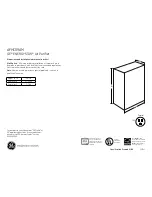
33
REFRIGERANT SERVICE PORTS
Each refrigerant system has a total of 2 Schrader-type service gage
ports per circuit. One port is located on the suction line, and one
on the compressor discharge line. Be sure that caps on the ports
are tight.
WATER PIPING
Verify water piping is properly installed and water flow is pres-
ent prior to operating unit. Check for water leaks and correct as
needed.
CV Unit Start-Up
EVAPORATOR FAN
Fan belt and variable pitch motor pulleys are factory installed. Be
sure that fans rotate in the proper direction.
COOLING
Set the space thermostat to OFF position. Turn on unit power. Set
space thermostat to COOL and the fan to AUTO. Adjust the ther-
mostat temperature setting below room temperature. Compressor
1 starts on closure of contactor (compressors 1 and 2 on 4-circuit
units with 2-stage thermostat).
Adjust the thermostat to an even lower setting until the thermostat
energizes Y2 (the second cooling stage). Compressor 2 starts on
closure of contactor (compressors 3 and 4 on 4-circuit units with
2-stage thermostat).
Adjust the thermostat temperature to a setting just below room
temperature. The second stage of cooling should turn off.
Set the thermostat temperature above room temperature. All com-
pressors and the unit fan should now be off.
Set the thermostat below room temperature and confirm that the
compressors and fan turn off.
CONTROLS
Unit Protection Module (UPM)
GENERAL DESCRIPTION
The Unit Protection Module (UPM) as shown in Fig. 24 is a print-
ed circuit board (PCB) that interfaces with the thermostat for con-
stant volume units or the digital direct controller.
The main purpose of this device is to protect the compressors by
monitoring the different states of switches and sensors of each re-
frigerant circuit. This device provides time delays and protects the
unit against freezing of the water and refrigerant heat exchangers
as well as condensate overflow when the appropriate sensors are
installed.
FEATURES AND SAFETIES
Alarm output is Normally Open (NO) dry contact. If 24 vac output
is needed, R must be wired to the ALR-COM terminal; 24 vac will
be available on the ALR-OUT terminal when the unit is in alarm
condition. If pulse is selected, the alarm output will be pulsed.
Power Random Start-Up
This feature prevents multiple units sharing same electrical circuit
or network from starting at the same time. It assures that units
sharing the same electrical circuit do not demand high inrush cur-
rents simultaneously when starting back up after a power failure.
If the controller has been completely powered down for more than
28 milliseconds, a random delay is initiated. If the controller is set
to normal operation (test switch set to NO), then typically the unit
will start within the time range of 270 to 300 seconds.
In order for the random sequence to initiate the unit power must be
removed completely.
Anti-Short Cycle Delay
This feature protects the compressor short cycling if the Y call is
set and removed. The anti-short cycle delay is 300 seconds on
break during normal operation.
NOTE: If the board is set to test mode through the “TEST” DIP
switch, the delay will be 5 seconds.
High and Low Pressure Protection
The UPM monitors the state of the high and low pressure switch
inputs of each refrigerant circuit, HP1, LP1, HP2, and LP2. These
switches must be closed for the controller to energize the compres-
sor output (CC1 and CC2). The CC output will only be energized
when the switches are closed and the anti-short cycle (and/or ran-
dom start-up when applicable) has expired.
IMPORTANT: If the board is set to “TEST” mode through the
“TEST” DIP switch, SW1 delay will be 10 seconds.
















































